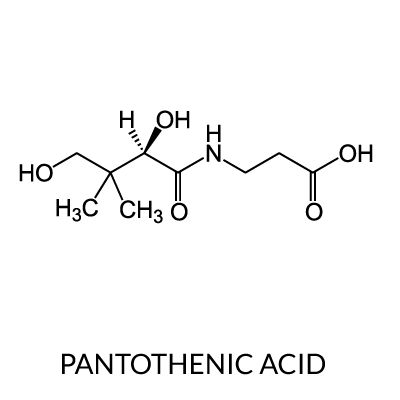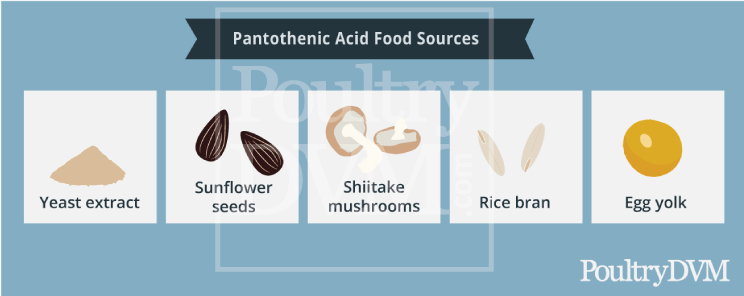Pantothenic acid, also called vitamin B5, is one of eight water-soluble B vitamins.
Pantothenic acid is found in two enzymes, coenzyme A (CoA) and acyl carrier protein (ACP), which are involved in many reactions in carbohydrate, fat and protein metabolism. In addition to playing a role in the breakdown of fats and carbohydrates for energy, vitamin B5 is critical to the manufacture of red blood cells, as well as sex and stress-related hormones produced in the adrenal glands. Pantothenic acid deficiency is somewhat rare in chickens, since this vitamin is ubiquitously found in foods of plant and animal origin.
Clinical Signs of Pantothenic Acid Deficiency
Pantothenic acid deficiency in chickens involves the skin, adrenal cortex, and nervous system. Most common clinical signs observed in affected birds includes:
- Flaking of skin layers between toes and on the bottoms of the feet. Followed by small cracks and fissures.
- Thickening of skin layers on the feet which cornify and produce wart-like lesions on the balls of the feet. These lesions often become infected by secondary bacteria resulting in abscesses.
- Flaking along the corners of the beak and the area just below the beak.
- Roughened and ruffled feathers, often become brittle and broken or fall off.
- Reduced growth and stunted feather growth.
- Reduced egg production in laying hens
- Embryos from panthothenic acid deficient hens may die during the later stages of the incubation period, caused by subcutanous hemorrhages and severe edema. Chicks that do survive the incubation period and hatch are often extremely weak and usually die soon after hatching.
Nutritional Recommendations for Pantothenic Acid
| Age/Life Stage | mg/kg |
|---|
| Newly Hatched Chicks (0 - 10 wks) | 15-17 |
| Young & Growing (10 - 20 wks) | 12.0-15 |
| Laying hens (Actively laying eggs) | 8.0-12 |
| Breeders (20 wks & older)* | 15.0-20 |
| Broiler/'Meat' Breed Chicks (0-18 wks) | 13.0-15 |
| Broiler/'Meat' Breeds* (19 wks & older) | 15-25 |
Pantothenic acid Food Sources
Pantothenic acid is widely distributed in feedstuffs of animal and plant origin. Alfalfa hay, yeast, rice bran, green leafy plants, wheat bran, brewer’s yeast, fish solubles, peanut meal, cane molasses, and rice polishings are good sources of the vitamin for chickens. Corn and soybean meal based feeds have lower levels of pantothenic acid.
Risk of Pantothenic Acid Toxicity
Pantothenic acid is thought to be relatively nontoxic, and dietary levels of at least 20 gm pantothenic acid per kg (9.0 gm per lb) can be tolerated by chickens.


